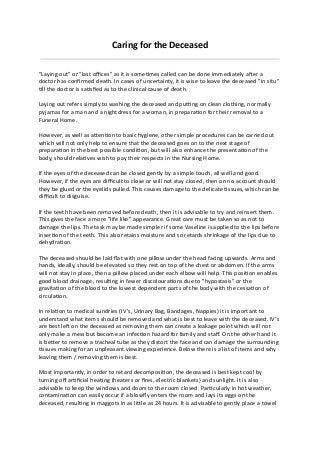Caring for the deceased - Google Docs
- 1. Caring for the Deceased
"Laying out" or "last offices" as it is someⳎmes called can be done immediately aᬚer a
doctor has confirmed death. In cases of uncertainty, it is wise to leave the deceased "in situ"
Ⳏll the doctor is saⳎsfied as to the clinical cause of death.
Laying out refers simply to washing the deceased and pu⾨ng on clean clothing, normally
pyjamas for a man and a nightdress for a woman, in preparaⳎon for their removal to a
Funeral Home.
However, as well as aⷾenⳎon to basic hygiene, other simple procedures can be carried out
which will not only help to ensure that the deceased goes on to the next stage of
preparaⳎon in the best possible condiⳎon, but will also enhance the presentaⳎon of the
body, should relaⳎves wish to pay their respects in the Nursing Home.
If the eyes of the deceased can be closed gently by a simple touch, all well and good.
However, if the eyes are difficult to close or will not stay closed, then on no account should
they be glued or the eyelids pulled. This causes damage to the delicate Ⳏssues, which can be
difficult to disguise.
If the teeth have been removed before death, then it is advisable to try and reinsert them.
This gives the face a more "life like" appearance. Great care must be taken so as not to
damage the lips. The task may be made simpler if some Vaseline is applied to the lips before
inserⳎon of the teeth. This also retains moisture and so retards shrinkage of the lips due to
dehydraⳎon.
The deceased should be laid flat with one pillow under the head facing upwards . Arms and
hands, ideally, should be elevated so they rest on top of the chest or abdomen. If the arms
will not stay in place, then a pillow placed under each elbow will help. This posiⳎon enables
good blood drainage, resulⳎng in fewer discolouraⳎons due to "hypostasis" or the
gravitaⳎon of the blood to the lowest dependent parts of the body with the cessaⳎon of
circulaⳎon.
In relaⳎon to medical sundries (IV’s, Urinary Bag, Bandages, Nappies) it is important to
understand what items should be removed and what is best to leave with the deceased. IV’s
are best leᬚ on the deceased as removing them can create a leakage point which will not
only make a mess but become an infecⳎon hazard for family and staff. On the other hand it
is beⷾer to remove a tracheal tube as they distort the face and can damage the surrounding
Ⳏssues making for an unpleasant viewing experience. Below there is a list of items and why
leaving them / removing them is best.
Most importantly, in order to retard decomposiⳎon, the deceased is best kept cool by
turning off arⳎficial heaⳎng (heaters or fires, electric blankets) and sunlight. It is also
advisable to keep the windows and doors to the room closed. ParⳎcularly in hot weather,
contaminaⳎon can easily occur if a blowfly enters the room and lays its eggs on the
deceased, resulⳎng in maggots in as liⷾle as 24 hours. It is advisable to gently place a towel
